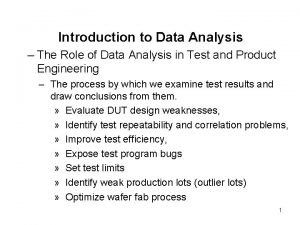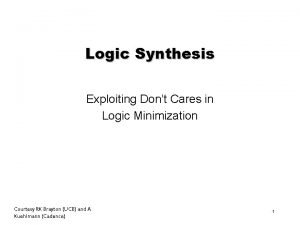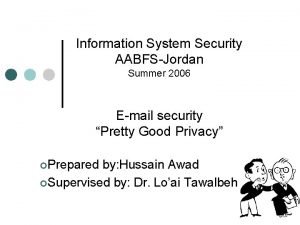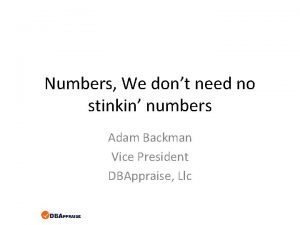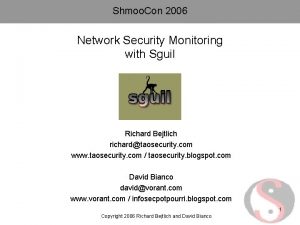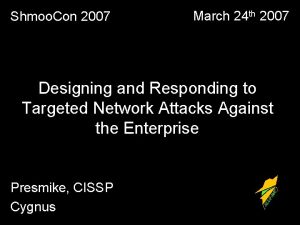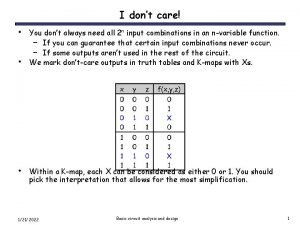Shmoo Con Moose I dont need no stinkin























![pico-wepcrack RC 4: for(i = 0; i < 256; i++) S[i] = i; // pico-wepcrack RC 4: for(i = 0; i < 256; i++) S[i] = i; //](https://slidetodoc.com/presentation_image_h2/8b94443d600f7bd1a18e60bb7d214bde/image-24.jpg)
![pico-wepcrack RC 4: for(i = 0; i < 256; i++) S[i] = i; // pico-wepcrack RC 4: for(i = 0; i < 256; i++) S[i] = i; //](https://slidetodoc.com/presentation_image_h2/8b94443d600f7bd1a18e60bb7d214bde/image-25.jpg)























































- Slides: 80

Shmoo. Con Moose? I don't need no stinkin moose Hacking the Airwaves with FPGAs Shmoo. Con 2007 David Hulton <david@toorcon. org> Chairman, Toor. Con Security R&D, Pico Computing, Inc. Researcher, The Open. Ciphers Project

Overview FPGAs – Quick Intro Cracking pico-wepcrack – WEP (Brute Force) jc-aircrack – WEP (FMS) NEW co. WPAtty – WPA Vile. Fault – Mac OS-X File. Vault NEW btpincrack – Bluetooth Authentication NEW Works in Progress NEW Conclusions

FPGAs Quick Intro Chip with a ton of general purpose logic ANDs, ORs, XORs Flip. Flops (Registers) Block. RAM (Cache) DSP 48’s (ALUs) DCMs (Clock Multipliers)

FPGAs Virtex-4 LX 25

FPGAs Virtex-4 LX 25 IOBs (448)

FPGAs Virtex-4 LX 25 IOBs Slices (10, 752)

FPGAs Virtex-4 LX 25 IOBs Slices DCMs (8)

FPGAs Virtex-4 LX 25 IOBs Slices DCMs Block. RAMs (72)

FPGAs Virtex-4 LX 25 IOBs Slices DCMs Block. RAMs DSP 48 s (48)

FPGAs Virtex-4 LX 25 IOBs Slices DCMs Block. RAMs DSP 48 s Programmable Routing Matrix (~18 layers)

Airbase

Airbase

jc-aircrack

jc-aircrack

jc-wepcrack

jc-wepcrack

jc-wepcrack, no pico

Accelerating brute forcing

Current arch

Future arch

Airbase

pico-wepcrack WEP Cracking Basics You sniff a packet Determine the RC 4 PRGA output by xor’ing the first few (ciphertext) bytes with the standard SNAP header (known plaintext) Run every possible key through RC 4 and compare PRGA output with output derived from the packet The key that has a matching PRGA is the correct key

pico-wepcrack FPGA Core Uses 32/48 custom RC 4 cores Uses Block. RAM for S-Boxes Will try every key between a start and end
![picowepcrack RC 4 fori 0 i 256 i Si i pico-wepcrack RC 4: for(i = 0; i < 256; i++) S[i] = i; //](https://slidetodoc.com/presentation_image_h2/8b94443d600f7bd1a18e60bb7d214bde/image-24.jpg)
pico-wepcrack RC 4: for(i = 0; i < 256; i++) S[i] = i; // Initialization for(i = j = 0; i < 256; i++) { j += S[i] + K[i]; Swap(S[i], S[j]); } // KSA for(i = 1, j = 0; ; i++) { j += S[i]; Swap(S[i], S[j]); PRGA[i – 1] = S[S[i] + S[j]]; } // PRGA
![picowepcrack RC 4 fori 0 i 256 i Si i pico-wepcrack RC 4: for(i = 0; i < 256; i++) S[i] = i; //](https://slidetodoc.com/presentation_image_h2/8b94443d600f7bd1a18e60bb7d214bde/image-25.jpg)
pico-wepcrack RC 4: for(i = 0; i < 256; i++) S[i] = i; // Initialization for(i = j = 0; i < 256; i++) { j += S[i] + K[i]; Swap(S[i], S[j]); } // KSA // K is input for(i = 1, j = 0; ; i++) { j += S[i]; Swap(S[i], S[j]); PRGA[i – 1] = S[S[i] + S[j]]; } // PRGA is output

pico-wepcrack Direct mapping from K -> PRGA But we need PRGA -> K Search all of K for matching PRGA

pico-wepcrack RC 4 Key: 0 Computer Start: 0 End: 16 PRGA: 0 xf 00 d RC 4 Keygen Key: 1 RC 4 Key: 2 RC 4

pico-wepcrack RC 4 PRGA: 0 xd 00 d Computer Start: 0 End: 16 PRGA: 0 xf 00 d RC 4 Keygen PRGA: 0 xbeef RC 4 PRGA: 0 xdead RC 4

pico-wepcrack RC 4 3 Computer Start: 0 End: 16 PRGA: 0 xf 00 d RC 4 Keygen 4 RC 4 5 RC 4

pico-wepcrack RC 4 PRGA: 0 xbead Computer Start: 0 End: 16 PRGA: 0 xf 00 d RC 4 Keygen PRGA: 0 xcafe RC 4 PRGA: 0 xf 00 d RC 4

pico-wepcrack RC 4 PRGA: 0 xbead Computer Start: 0 End: 16 PRGA: 0 xf 00 d RC 4 Keygen PRGA: 0 xcafe RC 4 PRGA: 0 xf 00 d RC 4

pico-wepcrack RC 4: Initialization can happen in parallel with KSA & PRGA for(i = 0; i < 256; i++) S[i] = i; // Initialization // S-Box must be reset for(i = j = 0; i < 256; i++) { j += S[i] + K[i]; Swap(S[i], S[j]); } // KSA for(i = 1, j = 0; ; i++) { j += S[i]; Swap(S[i], S[j]); PRGA[i – 1] = S[S[i] + S[j]]; } // PRGA

Performance Comparison PC FPGA jc-wepcrack 1. 25 GHz G 4 3. 6 GHz P 4 pico-wepcrack LX 25 ~12, 000/sec 15 Cluster ~180, 000/sec ~150, 000/sec ~300, 000/sec ~42 Days to break 40 -bit PS 3 cbe-client (Thx HDM!) 1 SPU 3. 2 GHz ~241, 000/sec 6 SPU 3. 2 GHz ~1, 446, 000/sec ~8. 8 Days to break 40 -bit ~25 Hours to break 40 -bit 100 Minutes on a 15 Cluster

pico-wepcrack + + =?

jc-aircrack + =?

Demo

Introduction to WPA Wi. Fi Protected Access

Introduction to WPA PSK MK is your passphrase It’s run through PBKDF 2 to generate the PMK

Introduction to WPA PSK MK is your passphrase It’s run through PBKDF 2 to generate the PMK

Introduction to WPA PSK MK is your passphrase It’s run through PBKDF 2 to generate the PMK

Introduction to WPA For every possible PMK compute PTK and see if it matches the handshake captured on the network

FPGA co. WPAtty Uses 8 SHA-1 Cores Uses Block. RAM to buffer the words fed to the cores As long as the machine is able to supply words fast enough, the SHA-1 cores will be utilized fully

Performance Comparison PC FPGA Cowpatty 800 MHz P 3 ~25/sec 3. 6 GHz P 4 ~60/sec AMD Opteron ~70/sec 2. 16 GHz Intel. Duo ~70/sec Aircrack 3. 6 GHz P 4 ~100/sec LX 25 15 Cluster LX 50 ~430/sec ~6, 500/sec ~650/sec

Results Decided to compute hash tables for a 1, 000 passphrase wordlist for the top 1, 000 SSIDs “That million word list that I fed you incorporated a 430, 000 word list from Mark Burnett and Kevin Mitnick (of all people) and was made up of actual harvested passwords acquired through some google hacking. They are passwords that people have actually used. I padded it out to 1 million by adding things like websters dictionary, and other such lists, and then stripped the short word (<8 chars. ) out of it. ”

Results Finally have the 40 GB WPA tables on the tubes Thanks Shmoo! (3 ric. J & Holt!) Check the Torrent trackers for seeds

FPGA co. WPAtty + + =?

Demo

Demo Oh, did I mention windows support?

Vile. Fault “File. Vault secures your home directory by encrypting its entire contents using the Advanced Encryption Standard with 128 bit keys. This high-performance algorithm automatically encrypts and decrypts in real time, so you don’t even know it’s happening. ”

Vile. Fault We wanted to know what was happening

Vile. Fault Stores the home directory in a DMG file DMG is mounted when you login hdi framework handles everything Blocks get encrypted in 4 k. Byte “chunks” AES 128, CBC mode Keys are encrypted (“wrapped”) in header of disk image Wrapping of keys done using 3 DES-EDE Two different header formats (v 1, v 2) Version 2 header: support for asymmetrically (RSA) encrypted header

Vile. Fault Apple's File. Vault Uses PBKDF 2 for the password hashing Modified version of the WPA attack can be used to attack File. Vault Just modified the WPA core to 1000 iterations instead of 4096 Worked with Jacob Appelbaum & Ralf-Philip Weinmann to reverse engineer the File. Vault format and encryption

Vile. Fault Login password used to derive key for unwrapping Crypto parts implemented in CDSA/CSSM PBKDF 2 (PKCS#5 v 2. 0), 1000 iterations Disk. Images has own AES implementation, pulls in SHA-1 from Open. SSL dylib “Apple custom” key wrapping loosely according to RFC 2630 in Apple's CDSA provider (open source)

Vile. Fault vfdecrypt (Ralf Philip-Weinmann & Jacob Appelbaum) Will use the same method with a correct password to decrypt the DMG file and output an unencrypted DMG file Result can be mounted on any system without a password vfcrack (me!) Unwrap the header Use header to run PBKDF 2 with possible passphrases Use PBKDF 2 hash to try and decrypt the AES key, if it doesn't work, try next passphrase With the AES key decrypt the beginning of the DMG file and verify the first sector is correct (only needed with v 2)

Vile. Fault Other attacks Swap Hibernation The key can get paged to disk (whoops!) Encrypted swap isn't enabled by default You can extract the File. Vault key from a hibernation file Ring-0 code can find the key in memory Weakest Link The password used for the File. Vault image is the same as your login password Salted SHA-1 is much faster to crack than PBKDF 2 (1 iteration vs 1000) The RSA key is easier to crack than PBKDF 2

Performance Comparison PC FPGA vfcrack 800 MHz P 3 ~100/sec 3. 6 GHz P 4 ~180/sec AMD Opteron ~200/sec 2. 16 GHz Intel. Duo ~200/sec LX 25 LX 50 15 Cluster ~2, 000/sec ~30, 000/sec

Demo

Bluetooth PIN Cracking Pairing bluetooth devices is similar to wifi authentication Why not crack the bluetooth PIN? Uses a modified version of SAFER+ inherently runs much faster in hardware Attack originally explained and published by Yaniv Shaked and Avishai Wool Thierry Zoller demonstrated his own tool at hack. lu

Bluetooth PIN Cracking How it works Capture a bluetooth authentication (sorry, requires an expensive protocol analyzer) This is what you'll see Master in_rand m_comb_key m_au_rand m_sres Slave master sends a random nonce s_comb_key s_res s_au_rand sides create key based on the pin master sends random number slave hashes with E 1 and replies slave sends random number master hashes with E 1 and replies

Bluetooth PIN Cracking Just try a PIN and if the hashes match the capture, it is correct Extremely small keyspace since most devices just use numeric PINs (1016) My implementation is command line and should work on all systems with or without FPGA(s)

Bluetooth PIN Cracking FPGA Implementation Requires implementations of E 21, E 22, and E 1 which all rely on SAFER+ Uses 16 -stage pipeline version of SAFER+ which feeds back into itsself after each stage To explain, here's some psuedocode

Bluetooth PIN Cracking for(pin = 0; ; pin++) { Kinit = E 22(pin, s_bd_addr, in_rand); // determine initialization key m_comb_key ^= Kinit; s_comb_key ^= Kinit; // decrypt comb_keys m_lk = E 21(m_comb_key, m_bd_addr); s_lk = E 21(s_comb_key, s_bd_addr); lk = m_lk ^ s_lk; // determine link key m_sres_t = E 1(lk, s_au_rand, m_bd_addr); // verify authentication s_sres_t = E 1(lk, m_au_rand, s_bd_addr); if(m_sres_t == m_sres && s_sres_t == s_sres) found! }

Bluetooth PIN Cracking for(pin = 0; ; pin++) { Kinit = E 22(pin, s_bd_addr, in_rand); // determine initialization key m_comb_key ^= Kinit; s_comb_key ^= Kinit; // decrypt comb_keys m_lk = E 21(m_comb_key, m_bd_addr); s_lk = E 21(s_comb_key, s_bd_addr); lk = m_lk ^ s_lk; // determine link key m_sres_t = E 1(lk, s_au_rand, m_bd_addr); // verify authentication s_sres_t = E 1(lk, m_au_rand, s_bd_addr); if(m_sres_t == m_sres && s_sres_t == s_sres) found! }

Bluetooth PIN Cracking E 22 PIN Gen 16 PINs SAFER+

Bluetooth PIN Cracking E 21 PIN Gen 16 clock cycles later SAFER+ Output loops back and SAFER+ now does E 21 for the Master

Bluetooth PIN Cracking E 21 PIN Gen 16 clock cycles later SAFER+ Then does the second E 21 for the Slave and combines the keys to create the link key

Bluetooth PIN Cracking E 1 PIN Gen 16 clock cycles later SAFER+ Then the first part of E 1 for the Slave

Bluetooth PIN Cracking E 1 PIN Gen 16 clock cycles later SAFER+ Then the second part of E 1 for the Slave

Bluetooth PIN Cracking E 1 PIN Gen 16 clock cycles later SAFER+ Then the first part of E 1 for the Master

Bluetooth PIN Cracking E 1 PIN Gen 16 clock cycles later SAFER+ Then the second part of E 1 for the Master

Bluetooth PIN Cracking E 22 PIN Gen 16 clock cycles later SAFER+ SRES Compare N Y Stop Then checks all of the sres values to see if any match while the process starts over

Bluetooth PIN Cracking If the cracker stops the computer reads back the last generated PIN from the pin generator to determine what the valid PIN was The last generated PIN – 16 should be the cracked PIN

Performance Comparison PC FPGA btpincrack 3. 6 GHz P 4 ~40, 000/sec BTCrack 3. 6 GHz P 4 LX 25 ~10, 000/sec 15 Cluster ~150, 000/sec LX 50 ~15, 000/sec ~100, 000/sec 0. 24 secs to crack 4 digit 42 min to crack 8 digit 0. 001 secs to crack 4 digit 10 secs to crack 8 digit

Works in Progress Salted SHA-1 Hashes Can do ~12 M/sec Requires more bandwidth to the card Currently implementing it on the E-16 Plugins to Jt. R With the higher speed interface we can accelerate cracking other hashes as well Can drop directly into Jt. R or just use Jt. R to create wordlists Typically our only limitation would be the bandwidth

Conclusion Get an FPGA and start cracking! Make use if your hardware to break crypto Add cool ascii matrix fx when you can : -) Choose bad passwords (please!) Don't feed the moose

Hardware Used Pico E-12 Compact Flash 64 MB Flash 128 MB SDRAM Gigabit Ethernet Optional 450 MHz Power. PC 405

Hardware Used Pico E-12 Super Cluster 15 - E-12’s 2 - 2. 8 GHz Pentium 4’s 2 - 120 GB HDD 2 - DVD-RW 550 Watt Power Supply

Future Hardware Pico E-16 Express. Card 34 Works in Mac. Book Pros 2. 5 Gbps full-duplex Virtex-5 LX 50 (~2 x faster) 32 MB SRAM External Express. Card Chip Made for Crypto Cracking More affordable Availability - Soon

Thanks Johny Cache (airbase/jc-wepcrack/jc-aircrack) Josh Wright (cowpatty) Render. Man (pmk hashtable monkey) Beetle (ghettopmk!) Jacob Appelbaum & Ralf-Philip Weinmann Audience (feel free to throw moosepattys now!!)

Questions? David Hulton david@toorcon. org http: //www. openciphers. org http: //www. picocomputing. com http: //www. toorcon. org http: //www. 802. 11 mercenary. net http: //www. churchofwifi. org
 Dont ask dont tell political cartoon
Dont ask dont tell political cartoon Dont laugh at me dont call me names
Dont laugh at me dont call me names Probe testing in vlsi
Probe testing in vlsi Shmoo plot
Shmoo plot Moose food web
Moose food web Optical illusions
Optical illusions Oscar nierstrasz
Oscar nierstrasz Hatchet moose attack
Hatchet moose attack Moose browse
Moose browse Moose food chain
Moose food chain Pebblego
Pebblego Bull moose
Bull moose An aircraft monikko
An aircraft monikko Goose on a moose
Goose on a moose Which phrase best describes the process of sampling
Which phrase best describes the process of sampling Khi tình yêu con còn mơ tin yêu con dệt thơ
Khi tình yêu con còn mơ tin yêu con dệt thơ What you dont know wont hurt
What you dont know wont hurt Pronom relatif
Pronom relatif Please dont eat my cookie
Please dont eat my cookie How does the cockle avoid the moon snail?
How does the cockle avoid the moon snail? Verilog dont care
Verilog dont care Dont ou où
Dont ou où Dont qui que
Dont qui que Masayasu wakabayashi meme
Masayasu wakabayashi meme Don't eat in the classroom
Don't eat in the classroom Clip clop and you don't stop
Clip clop and you don't stop Dancing yeah yeah ba ba ba
Dancing yeah yeah ba ba ba Dont eat in the class
Dont eat in the class How do you do a z in sign language
How do you do a z in sign language Show don't tell excitement
Show don't tell excitement Dont worry be happy notes
Dont worry be happy notes Dont drink the koolaid meaning
Dont drink the koolaid meaning Why dont water and oil mix
Why dont water and oil mix Dont look up tick
Dont look up tick Plural forms of words
Plural forms of words Show not tell technique
Show not tell technique Dont remplace
Dont remplace Dont que
Dont que I dont care ascii
I dont care ascii Dont count on people
Dont count on people Don't call my bluff
Don't call my bluff I dont care ascii
I dont care ascii Wright vs. wrong
Wright vs. wrong Dont believe the world
Dont believe the world Dont eat in the classroom
Dont eat in the classroom Dont sacrifice pervades your mahal india
Dont sacrifice pervades your mahal india Dont cut the pasta
Dont cut the pasta Pablo neruda i don't love you
Pablo neruda i don't love you Linguo incisal ridge
Linguo incisal ridge People don't plan to fail
People don't plan to fail Dont save lives
Dont save lives Tomorrow i dont know
Tomorrow i dont know I dont know how to revise
I dont know how to revise Dont be dense
Dont be dense Don't touch lesions
Don't touch lesions Dont fud
Dont fud Dont give away
Dont give away Dont forget to join
Dont forget to join Dont be late
Dont be late Dont ask
Dont ask Dont assume quotes
Dont assume quotes Chomp chomp exercises
Chomp chomp exercises I dont feel respected
I dont feel respected Dont eat in class
Dont eat in class I dont know where youre going
I dont know where youre going I dont play football
I dont play football Please dont throw
Please dont throw Dont expect more
Dont expect more Dont tense
Dont tense Smooth seas do not make skillful sailors.
Smooth seas do not make skillful sailors. I just wanna be a sheep sheet music
I just wanna be a sheep sheet music I don't know tomorrow
I don't know tomorrow Words for dont care
Words for dont care Show not tell examples
Show not tell examples Where was george best born
Where was george best born Dont worry be ready
Dont worry be ready Dont reply all
Dont reply all Dont get burned
Dont get burned Dont be a dope
Dont be a dope Dont ask what
Dont ask what You cant manage what you dont measure
You cant manage what you dont measure



